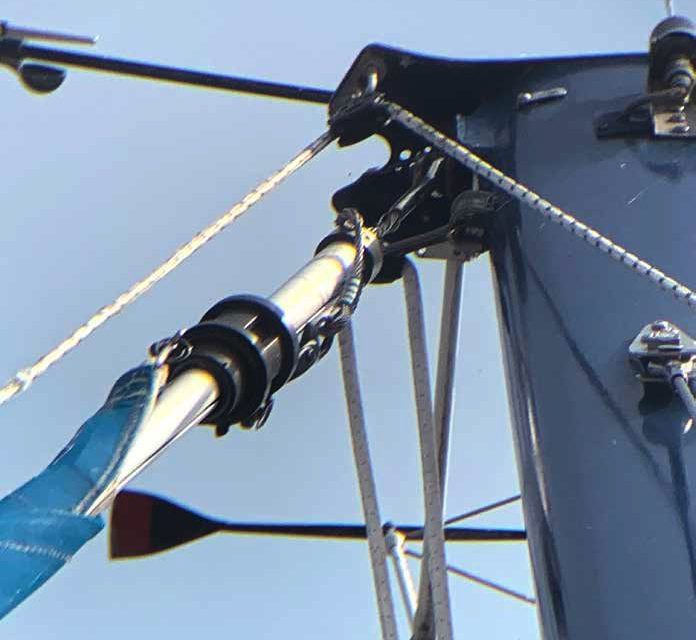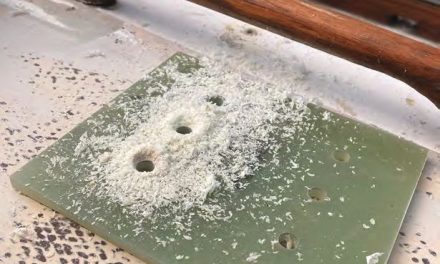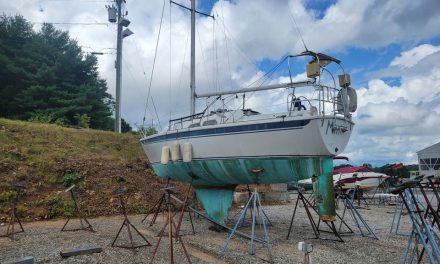A momentary mistake with a jib changes a family’s summer sailing plans
Issue 152: Sept/Oct 2023
There comes a point in every adventure aboard our boat when my husband and I ask ourselves, “Why are we doing this?” This question usually arises as the toddler has a tantrum because we said no to a third lollipop, or as the baby cries and refuses to nap on a passage, or in stressful moments of docking while the children wreak havoc in the cabin below.
Undeniably, though, we find that when all is said and done, when the boat is tucked into her cradle and wrapped snugly in her cover for the winter, we say resoundingly, “I’m so glad we did that.”
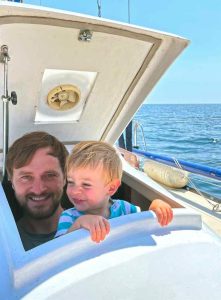
Elliot smiles into the wind with Colin.
While the tears and tantrums can overshadow a moment, there is nothing we would rather do than show our boys the beauty of the world — to help them slow down and appreciate the magnitude of a starry night or the sound of the water lapping against the hull. And amidst the complaining about long passages, being hot or cold, upset tummies, or any other myriad reasons to complain, our young boys crave the boat. They spend the winter making sailboats from our couch cushions, wearing life jackets in the house, using ropes to tether each other to certain pieces of furniture as they pretend we are underway. There is magic that happens on the boat together when the whole family is snugly in our berths, able to talk to each other until we drift off to sleep.
With our 1978 C&C 30, Juniper, provisioned and the weather conditions looking favorable, our crew of four set out for a 10-day trip up and down the eastern shore of Lake Michigan in July 2022. We had no solid plans, just hopes of hopping from port to port and making memories along the way. Through the seasons, we have learned that with a 1- and 4-year-old as our crew, we are mostly fair-weather sailors. It is most important to us that they grow up loving the boat instead of resenting it. For now, that means minimal waves and plenty of sunshine. But as we sailed into our first port on that trip, I made a mistake that altered the rest of our vacation and the remainder of our summer sailing season.
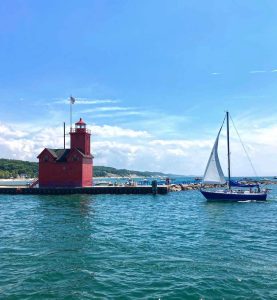
Sailing Juniper past the Holland Harbor
Lighthouse, with the headsail out.
The sun was high as we sailed past the Holland Harbor Lighthouse. We were feeling pretty accomplished that the kids were in great spirits after a lengthy day on the water. My husband was down in the cabin preparing dinner, and as I navigated toward the marina, I decided to pull the headsail in so I could see a bit better on a busy and shallow lake. I was met with a lot of resistance and figured that I was just weak. Rather than calling for muscle from my husband, I thought I’d use my creativity to solve the problem.
I wrapped the furling line around the winch and started to crank the headsail in — I know, I know, many of you are rolling your eyes and thinking it is common sailing knowledge that you never, ever winch your roller-furling line. Much like a horror movie when the audience can see what the characters cannot, I was unaware that this was something I should refrain from doing at all costs. It was an ordeal to get the jib in. Even with the line on the winch, I had to call my husband. We spun into the wind and cranked and pulled and grunted and pulled, and eventually we got it in.
At the dock, my kids were clamoring to go to the pool and the playground. I let the headsail drama go and set out to explore with our boys. Colin, our captain, wanted to check things out with the sail before he settled into vacation mode. In the moment, I was annoyed that he couldn’t just let it go and enjoy family time. In hindsight, I am beyond glad that he knew not to give it up.
While the boys and I played and swam, Colin spent time taking photos of the standing rigging through the lens of our binoculars. This allowed him to get a close look at what was happening. He discovered that the jib halyard was wrapped around the forestay and had frayed some of its wires. It was hard to tell in the pictures just how bad the damage was, but we knew it wasn’t good. The mood on the boat turned from a joy-filled start of a vacation to some very real fears about just how close we were to the potential of our mast coming down without notice.
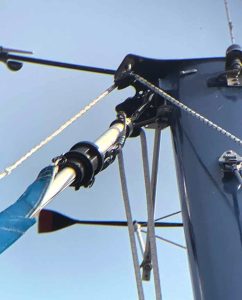
The top of Juniper’s mast showing the halyard wrap.
Colin and I spent the evening in the cockpit devising plans. When something goes awry on the water, there are more issues at stake than just what is broken. When things go wrong, we are faced with the challenge of being the people we want to be in hard situations; what does it look like to be creative and resilient and joyful in the face of a massive setback? How do we channel our inner Lin and Larry Pardey? How do we hone our ability to research and fix the problem, salvage the precious vacation days, and keep the family’s spirits high as we change the plan?
We spun our wheels debating if it was safe to motor farther south to continue with our vacation or if we needed to get home as soon as possible. We wondered if it was safe to even motor home with the kids on board. We wondered, “Why are we doing this?”
There are times when I’m struck by worry about what other people think of our life. Beyond my internal question of why we are doing this, I fear that those around us look at us and wonder why on earth we are out on the water with our young family. I wonder if mistakes like these make highly skilled sailors laugh at us just learning as we go. I question if we should put the boat up for sale and shift toward easier land-based adventures.
As I can spin down this rabbit hole of what other people think, I can also see what others can’t. I can see the sheer glee on my boys’ faces as they smile into the wind. I hear their laughter as they play in the V-berth. I see what they are learning as they watch their parents learn. There is beauty in the hardship. There are lessons I can’t teach them but by example. For as much as I want to be the best version of myself in a challenging situation, I also want them to see the best version of me.
As every sailor does, we recalibrated. We formed a plan. We connected our spinnaker halyard to the bow pulpit and used it as a stabilizer. Next, we took the foresail down and used the halyard as a second reinforcement. Colin read nearly every article on the internet about halyard wrap, what to do about it, and how to prevent it. We went to sleep feeling nervous but certain that we were safe. While we do almost all the maintenance and repairs on Juniper ourselves, replacing the standing rigging was a task we deemed worthy of professional help. The next morning, we called Torresen Marine in Muskegon, Michigan. They assured us they could replace the forestay and get us back on the water within a few days.
As the pieces fell into place, we turned to figuring out how to enjoy our vacation. We spent a few days in Holland and then motored up to Grand Haven for a few more days. As the forecast shifted and the wave predictions got larger, we knew it was time to run home to get Juniper fixed. We returned home a bit deflated. Our summer was altered that day. Some of our worries and fears were heightened by this event, and it has slowed us down and caused us to be a little more prudent. We are still coming to trust ourselves and our boat again.
Allie is a dreamer and adventure enthusiast who spends her summers sailing the coast of Lake Michigan with her husband, Colin, and their two young boys. She spends her winters working on boat projects at home and dreaming of warmer weather.
Thank you to Sailrite Enterprises, Inc., for providing free access to back issues of Good Old Boat through intellectual property rights. Sailrite.com

